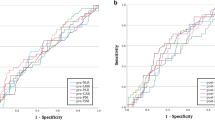Purpose:
The purpose of this study was to analyze the prognostic value of baseline hemoglobin levels before radiotherapy in patients with head and neck tumors. Patients and Methods: Results: Conclusion:
Patients and Methods:
In a retrospective study with a median follow-up of 43 months, we analyzed the results of 214 patients irradiated for head and neck cancer between January 1, 1990 and January 1, 1998 (180 men and 34 women; median age 58 years). The treatment concept consisted in adjuvant radiotherapy in 58 patients, 77 patients received definitive radiochemotherapy, 42 patients definitive radiotherapy, and 37 patients reirradiation for in-field recurrence. Baseline hemoglobin values were divided in four groups of the same patient number (quartiles). Several known prognostic factors like sex, age, tumor stage, histologic grading, performance status, and treatment scheme were analyzed for their influence on overall and event-free survival and correlated with pretreatment hemoglobin values (Kaplan-Meier method). In addition, univariate und multivariate logistic regression analyses were carried out to evaluate the effect of baseline hemoglobin on response rates.
Results:
The median survival (event-free survival) of all patients amounted to 15 months (10 months). 25%, 50%, and 75% of patients had hemoglobin values < 11.2 g/dl, < 12.7 g/dl, and < 13.9 g/dl, respectively. In the univariate analysis, the following variables were significant prognostic factors for overall/event-free survival (log-rank test): treatment concept (p < 0.001/ p < 0.001), tumor stage (p < 0.001/p < 0.001), general condition (p < 0.001/p < 0.001), and pretreatment hemoglobin (p = 0.014/p = 0.05). Multivariate analysis (Cox) proved these parameters to be independent of each other. In addition, response rate after radiation showed a strong association between hemoglobin and local control probability (p = 0.02).
Conclusion:
In this retrospective analysis, baseline hemoglobin level was shown to be an independent significant prognostic factor in radiotherapy of head and neck cancer patients. Therefore, the value of tumor anemia as a prognostic factor should be emphasized more.
Ziel:
Der prognostische Wert des prätherapeutischen Hämoglobinwerts vor Strahlentherapie wurde retrospektiv bei Patienten mit Kopf-Hals-Malignomen untersucht.
Patienten und Methodik:
In einer retrospektiven Studie wurden die Ergebnisse von 214 Patienten (medianes Follow-up 43 Monate) analysiert, die vom 01.01.1990 bis zum 01.01.1998 wegen eines Kopf-Hals-Malignoms bestrahlt wurden (180 Männer; 34 Frauen; medianes Alter 58 Jahre). Die Behandlung war bei 58 Patienten adjuvant, 77 Patienten erhielten eine definitive Radiochemotherapie, 42 Patienten eine definitive Radiotherapie und 37 Patienten eine Wiederholungsbestrahlung nach In-field-Rezidiv. Die prätherapeutischen Hämoglobinwerte wurden in vier Gruppen gleicher Patientenzahl (Quartile) aufgeteilt. Bezogen auf das Gesamt- und ereignisfreie Überleben wurden bekannte prognostische Parameter wie Geschlecht, Alter, Tumorstadium, Grading, Allgemeinzustand und Behandlungsschema untersucht und dem prätherapeutischen Hämoglobinwert gegenübergestellt (Kaplan-Meier-Methode). Zusätzlich erfolgten ein univariater und ein multivariater Vergleich der Hämoglobinwerte mit der Remission mit Hilfe der logistischen Regressionsanalyse.
Ergebnisse:
Für alle Patienten betrug das mediane Gesamtüberleben (ereignisfreie Überleben) 15 Monate (10 Monate). 25% aller Patienten hatten Hämoglobinwerte < 11,2 g/dl, 50% < 12,7 g/dl und 75% < 13,9 g/dl. In der univariaten Analyse waren prognostische Faktoren für das Gesamtüberleben/ereignisfreie Überleben das Behandlungsschema (p < 0,001/p < 0,001), das Tumorstadium (p < 0,001/p < 0,001), der Allgemeinzustand (p < 0,001/p < 0,001) und der prätherapeutische Hämoglobinwert (p = 0,014/p = 0,05). In der multivariaten Analyse (Cox) waren diese Parameter signifikant unabhängig voneinander. Auch die Remission nach Strahlentherapie zeigte sich signifikant abhängig von den prätherapeutischen Hämoglobinwerten (p = 0,02).
Schlussfolgerung:
In dieser retrospektiven Analyse erwies sich der prätherapeutische Hämoglobinwert als signifikant unabhängiger prognostischer Parameter in der Strahlentherapie von Patienten mit Kopf-Hals-Karzinomen. Die Tumoranämie sollte als Prognosefaktor deshalb mehr beachtet werden.
Similar content being viewed by others
Author information
Authors and Affiliations
Corresponding author
Rights and permissions
About this article
Cite this article
Schäfer, ., Micke, O., Müller, S.B. et al. Hemoglobin as an Independent Prognostic Factor in the Radiotherapy of Head and Neck Tumors. Strahlenther Onkol 179, 527– 534 (2003). https://doi.org/10.1007/s00066-003-1117-x
Received:
Accepted:
Issue Date:
DOI: https://doi.org/10.1007/s00066-003-1117-x



